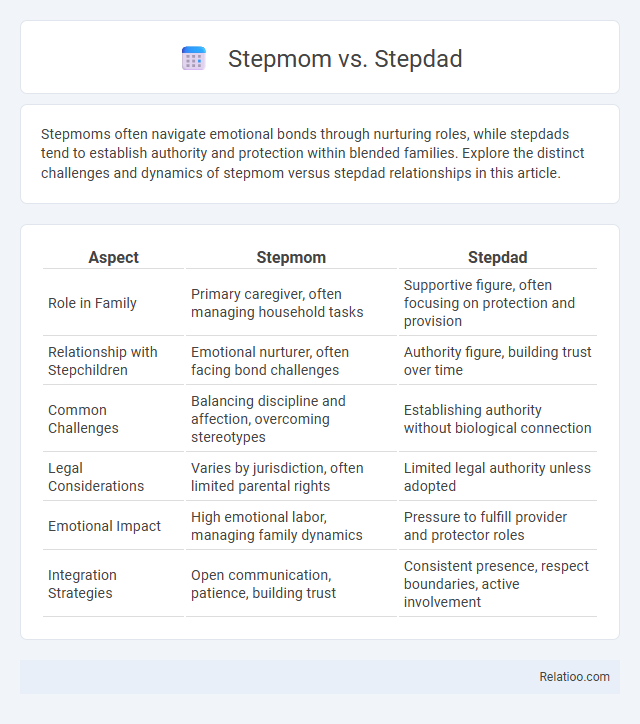Stepmoms often navigate emotional bonds through nurturing roles, while stepdads tend to establish authority and protection within blended families. Explore the distinct challenges and dynamics of stepmom versus stepdad relationships in this article.
Table of Comparison
| Aspect | Stepmom | Stepdad |
|---|---|---|
| Role in Family | Primary caregiver, often managing household tasks | Supportive figure, often focusing on protection and provision |
| Relationship with Stepchildren | Emotional nurturer, often facing bond challenges | Authority figure, building trust over time |
| Common Challenges | Balancing discipline and affection, overcoming stereotypes | Establishing authority without biological connection |
| Legal Considerations | Varies by jurisdiction, often limited parental rights | Limited legal authority unless adopted |
| Emotional Impact | High emotional labor, managing family dynamics | Pressure to fulfill provider and protector roles |
| Integration Strategies | Open communication, patience, building trust | Consistent presence, respect boundaries, active involvement |
Understanding the Roles: Stepmom vs Stepdad
Understanding the roles of stepmom vs stepdad involves recognizing the unique emotional dynamics and expectations each role carries within a blended family. Your ability to navigate role ambiguity depends on clear communication, setting boundaries, and embracing the distinct ways stepmoms and stepdads contribute to parenting and family cohesion. Addressing these nuances helps reduce confusion and fosters healthier relationships for all family members.
Common Challenges Faced by Stepmoms and Stepdads
Stepmoms and stepdads often face role ambiguity, leading to challenges in establishing authority and building trust with stepchildren. Common issues include navigating boundaries with biological parents, managing differing parenting styles, and overcoming feelings of exclusion or rejection within the family dynamic. These challenges require clear communication, patience, and consistent effort to foster healthy relationships and stability in blended families.
Emotional Dynamics in Blended Families
Emotional dynamics in blended families often reveal distinct challenges in the roles of stepmom and stepdad, where role ambiguity can lead to confusion and tension among family members. Stepmoms frequently face societal expectations of nurturing caregiving roles, which can complicate their emotional boundaries, while stepdads may struggle with balancing authority and acceptance. Clear communication and defined role clarity significantly reduce emotional strain, fostering healthier relationships and stability within blended family structures.
Parental Authority: Setting Boundaries and Expectations
Parental authority in stepfamilies often faces role ambiguity, impacting how boundaries and expectations are set between stepmom, stepdad, and children. Stepmoms may encounter challenges in asserting authority due to societal stereotypes, whereas stepdads frequently navigate expectations of traditional paternal roles. Clear communication and collaboration with your partner establish consistent rules, minimizing confusion and fostering respect within blended families.
Navigating Relationships with Biological Parents
Navigating relationships with biological parents can often create role ambiguity for stepmoms and stepdads, as each position requires balancing respect for the biological parent's role while establishing boundaries and authority in the family dynamic. Your approach should emphasize open communication and cooperation to foster trust and minimize conflicts between all parties involved. Understanding these nuances helps step-parents support their stepchildren effectively without overstepping or undermining the biological parent's influence.
Building Trust with Stepchildren
Building trust with stepchildren requires clear role definition, as stepmoms and stepdads often face role ambiguity that can hinder relationship development. Stepmoms may struggle with perceived authority while stepdads might encounter boundaries due to traditional paternal expectations, making consistent communication and respect essential. Establishing trust involves understanding individual family dynamics and demonstrating reliability, empathy, and patience over time.
Gender Stereotypes and Societal Expectations
Stepmom and stepdad roles often carry distinct gender stereotypes influenced by societal expectations, with stepmoms frequently viewed through nurturing and caregiving lenses, while stepdads are expected to embody authority and financial provision. Role ambiguity arises when these conventional norms conflict with individual family dynamics, leading to challenges in defining step-parents' boundaries and responsibilities. Understanding these gendered perceptions is crucial for addressing the complexities of blended family relationships and promoting more flexible, inclusive step-parenting roles.
Conflict Resolution Strategies in Stepfamilies
Conflict resolution strategies in stepfamilies must address role ambiguity often experienced by stepparents such as stepmoms and stepdads, who navigate shifting boundaries and expectations. Effective communication, clear role definition, and establishing consistent routines help reduce misunderstandings and foster trust among all family members. Your ability to implement collaborative problem-solving techniques and respect individual family dynamics is crucial for maintaining harmony and promoting emotional well-being in complex blended family relationships.
Impact on Child Development and Well-being
Role ambiguity in stepfamily dynamics, particularly between stepmoms and stepdads, significantly impacts child development and well-being by influencing emotional security and identity formation. Conflicting expectations and unclear boundaries can lead to increased stress and behavioral issues in children, hindering their socio-emotional growth and adjustment. Your active communication and consistent role definition help mitigate these effects, fostering a stable environment conducive to healthy child development.
Tips for a Successful Stepparenting Journey
Navigating stepmom and stepdad roles often involves managing role ambiguity, which can affect family harmony and personal identity. Establish clear boundaries, communicate openly with your partner and stepchildren, and embrace flexibility to foster trust and understanding in your blended family. Your willingness to adapt and affirm each individual's unique place helps create a supportive and successful stepparenting environment.

Infographic: Stepmom vs Stepdad
 relatioo.com
relatioo.com